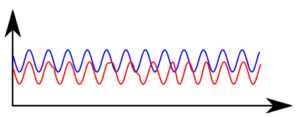Table of Contents
Coherence describes the interrelationship properties of physical quantities in a single wave or between several waves. The two waves are said to have been coherent if they have a constant relative phase or a zero or constant phase difference and the same frequency.
Coherence facilitates the wave’s property of stationary interference, in addition to the amount of coherence measured by interference visibility. For example, two coherent point sources can classify two parallel slits illuminated by a laser beam.

Types of Coherence
(1) Temporal coherence: Temporal coherence has been defined as the average relationship between the wave value and itself that causes a delay of τ at any definite number of times.
This characterises the interference of a wave with itself at a different time and gives the measure of a monochromatic source.
The coherence time can be defined as the significant amount above which the phase or amplitude is delayed (and thus the correlation decreases by a significant amount).
(2) Spatial Coherence: In the scenario of optics or water waves, we must determine the dimension of the wave that extends from one or two points.
Spatial coherence has been defined as the ability of two points in a wave space, such as x1 and x2, to interfere.
The cross-relationship of two points in a wave has been defined as spatial coherence.
The wave must have a single amplitude value over an infinite length to achieve perfect spatial coherence. The significant interference between the range of separation and the two points can be used to define the diameter of the coherence area Ac.
Applications of Coherence
Radiography is indeed a time-honoured technique. Which is replaced by a next-generation facility beam that makes it simple and possible to break through the traditional barrier to absorb and visualise phase features. The X-ray beam does have:
- A high spatial coherence, as well as very small size and divergence.
- Aromatization has good temporal coherence after mono.
Because of the beam’s super brilliance, new techniques in the X-ray field, phase-contrast imaging and tomography, in-line holography, and photon correlation spectroscopy can be developed.
Coherent Sources
A coherent source of light would be one that emits light waves that have the same frequency, wavelength, and phase or have a constant phase difference. Once waves superimpose and the maxima and minima positions are fixed, sustained interference patterns form.
Because all of the factors cannot be present in the source at the same time, two independent sources cannot be coherent.
FAQs
What are coherent sources?
Coherence facilitates the wave's property of stationary interference, in addition to the amount of coherence measured by interference visibility. A coherent source of light would be one that emits light waves that have the same frequency, wavelength, and phase or have a constant phase difference. Once waves superimpose and the maxima and minima positions are fixed, sustained interference patterns form.
Is Sun a Coherent Source?
The sun is really an incoherent source of light. Even so, sunlight can cause a coherence speckle in a microscope image. The majority of light sources interfere with spatial coherence (related to angular size) and temporal coherence (related to wavelength).







